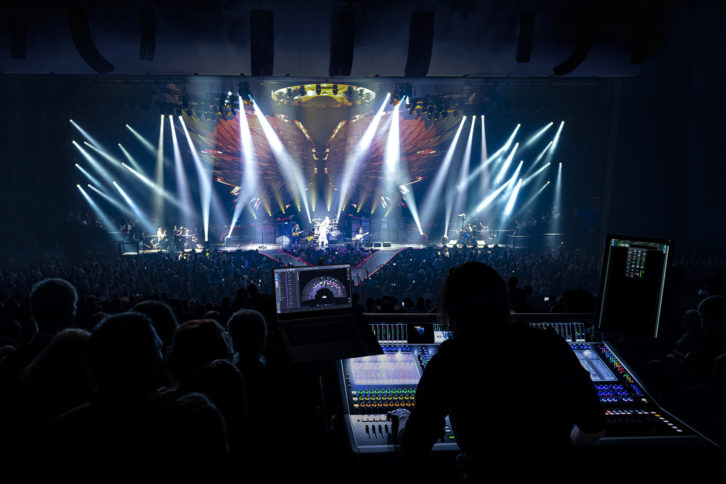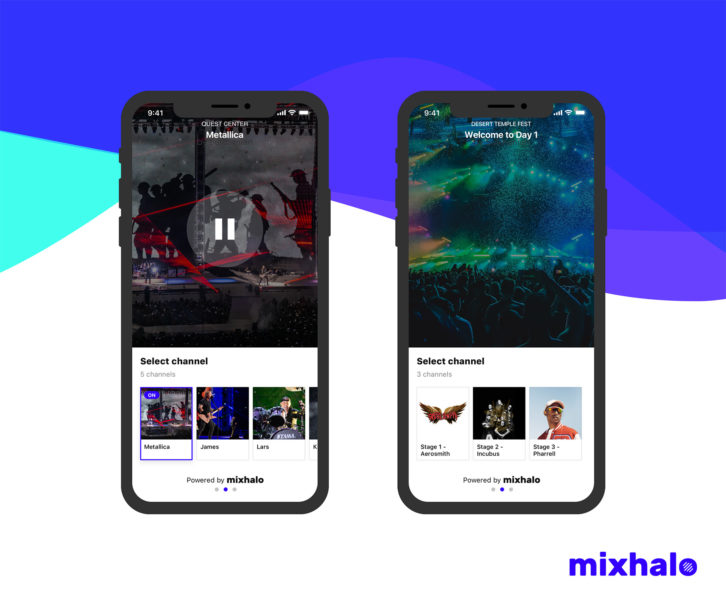
Over the past 30 years, California rock band Incubus has sold more than 23 million albums and headlined numerous music festivals and tours around the world. The group’s latest Live Nation-promoted US trek—billed as the 2022 Summer Tour, with openers Sublime with Rome and The Aquadolls—recently performed at 27 amphitheaters and pavilions across the country between July 24 and September 3, with sound reinforcement provider Clair Global carrying an L-Acoustics K Series system, augmented with extra content for fans in an on-stage VIP area via the Mixhalo realtime audio application.
The 2022 Summer Tour’s loudspeaker design was built around a pair of 16-enclosure K Series mains—12 K1 over four K2—with eight more K2 per side flown as out-fill arrays. Left and right hangs of six KS28 subs hung in cardioid configuration were bolstered by six more end-stacked on the stage below, also in a cardioid arrangement. Two A15 Wide per side flanked the ground subs for out-fill, while six A10 Focus spread across the stage lip delivered front-fill. The entire system was driven by LA12X amplifiers, housed in LA-RAK II touring racks, and managed via the L-Acoustics P1 AVB processor and measurement platform.
One additional unique component of the touring system was the use of the Mixhalo platform, which was co-founded by Incubus guitarist and songwriter, Mike Einziger. The Mixhalo deployment was designed to complement the main audience coverage via K1 by a unique VIP headphone solution on stage that delivers pristine, real-time audio content tailored to the stage experience.
“We’ve had Mixhalo out with us from the start, obviously,” shares FOH engineer Greg Nelson, who, in addition to his work with Pearl Jam, has mixed for Incubus on and off since 1997 when they opened for 311. “I send a leftright mix as well as four other mixes that highlight Ben, Mike, Kil, and José’s instruments on top of a left-right mix. The band sells a VIP package that allows fans to stand on the sides of the stage, approximately six feet from Ben and Mike, and Mixhalo allows them to hear a perfect mix of the show via headphones. We also have been using it in select venues for the lawn. I think it’s a good use of Mixhalo on the lawn because some venues’ lawn systems are pretty basic and hardly cover the large crowds that are there. Mixhalo gives people the option to listen when they want to and get a great mix.”
 Nelson details the mixing approach that he took on his DiGiCo Quantum338 console feeding the L-Acoustics system: “I like to start with a nice warm low end—a lot of 40 to 50 Hertz in the kick and let the bass fill in the rest,” he describes. “Ben [Kenney] has a great bass sound with a warm low end and a nice midrange that lets all the interesting things he’s playing cut through. Mike [Einziger] has a nice big guitar sound and I like to do a delay offset to create more space in the middle for vocals and all of the keyboard and turntable things that Kil [DJ Chris Kilmore] is doing. I like to try to get a big ‘everything is louder than everything else’ wall of sound and then let Brandon’s [Boyd] vocals sit right there on top. K1 is a great PA for all of this because of its natural warmth. The low mids are smooth, as is the high end, and it lets me get big and loud without any harshness or mud.”
Nelson details the mixing approach that he took on his DiGiCo Quantum338 console feeding the L-Acoustics system: “I like to start with a nice warm low end—a lot of 40 to 50 Hertz in the kick and let the bass fill in the rest,” he describes. “Ben [Kenney] has a great bass sound with a warm low end and a nice midrange that lets all the interesting things he’s playing cut through. Mike [Einziger] has a nice big guitar sound and I like to do a delay offset to create more space in the middle for vocals and all of the keyboard and turntable things that Kil [DJ Chris Kilmore] is doing. I like to try to get a big ‘everything is louder than everything else’ wall of sound and then let Brandon’s [Boyd] vocals sit right there on top. K1 is a great PA for all of this because of its natural warmth. The low mids are smooth, as is the high end, and it lets me get big and loud without any harshness or mud.”
Before he could get to that point, however, it was systems engineer John Kerns’ duty to design, set up, and ring out the rig at each tour stop. “I rely on Soundvision almost daily,” Kerns says. “The Autosolver tools allowed us to get a very good basic idea in just a few minutes. After using Autosplay, I typically looked at a couple of different frequency bands to see if we could get them pretty even, and then Autofilter was used to tighten things up even more. I’ve found that the filters that are tweaked in Autofilter are pretty spot on when you move between cabinets in the field.”
Once the PA was up and passing signal, Kerns ran Load Checker to ensure that all patching was correct. “We would then break into M1, which is a fantastic measurement tool suite. Once we got our workflow down, I found it not only highly accurate but really quite easy. We did all of our timing in M1 and 95 percent of our EQing as well—without needing 30 minutes of pink noise every day.”
The Incubus audio crew, which also included PA tech Keith Porter, ran the loudspeaker system on AVB as the primary signal transport, which Kerns says, “made it not only drop-dead quiet, but super easy for any changes that had to be made for slightly different array configurations from day to day. In the few months that we were out, we never had a single slip or dropout. The P1 processor is an integral part of the L-Acoustics ecosystem and an equally important component as any amplifier or cabinet, in my opinion.”
Whether they were using headphones on stage or feeling the K1 impact in the audience, fans were “plugged in” to the band thanks to the full coverage premium solution.










